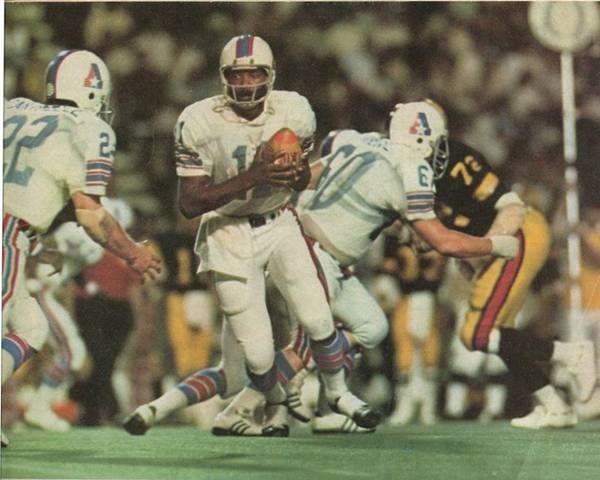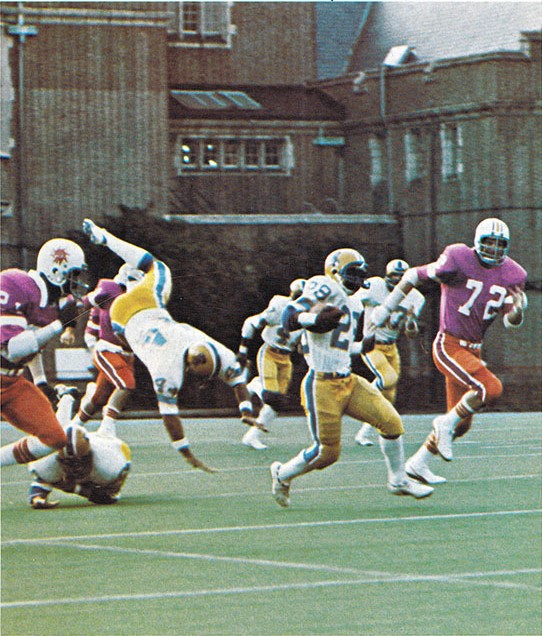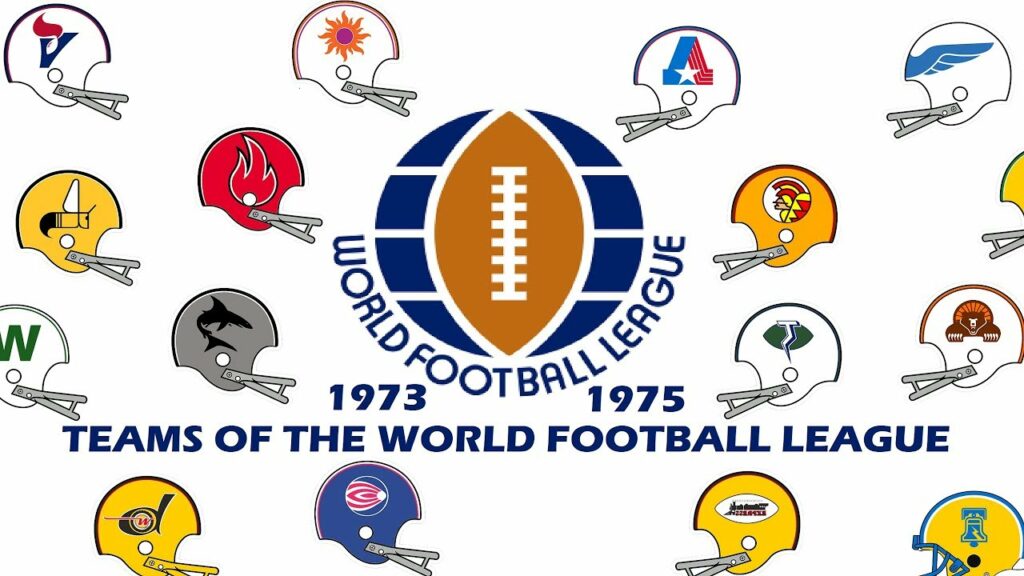Sports
History Of The World Football League 1974-1975
Gary L. Davidson officially launched the World Football League in Chicago, on October 2, 1973. It had been four years since the other two pro grid leagues, the 50-something National Football League melded the 10-year old American Football League into a 26-team superpower. In Davidson’s sports memoir, Breaking the Game Wide-Open, his view for another football league had been a necessity. Or as he put it more succinctly, the lords of Sunday afternoon had “become arrogant and fat. We’re ready to take on the big boys now,” declared Davidson.
The World Football League (WFL) emerged onto the American football scene in 1974, completing one full season and a significant portion of its second in 1975. Despite its aspirations to globalize American football, the WFL’s reach extended only as far as placing a single team, the Hawaiians, in Honolulu, Hawaii. Regrettably, the league ceased operations midway through its sophomore season. In 2008, a revival of sorts occurred with the inception of a new minor football league under the same moniker, after securing the rights to the original league’s trademarks and intellectual property. However, this reincarnation was short-lived, folding in 2011.
1974 Season Of The World Football League

Playing a 20-game regular season schedule in 1974 – six games longer than the NFL’s then 14-game slate – the World Football League staged no exhibition games (although their teams did participate in preseason scrimmages). The season was scheduled to begin on Wednesday, July 10, and end on Wednesday, November 13. This was a 20-game season in 19 weeks – a schedule accomplished by having double games (primarily Monday and Friday) on Labor Day weekend.
Opening night, July 10, 1974, five World Football League openers in Birmingham, Chicago, Memphis, Orlando, and Philadelphia attracted more gridiron fans than expected.
The Bell, who only sold roughly 5,000 season tickets, outdrew the baseball Phillies, 55,534 to 33,000. 53,231 came out for its first-ever regular season pro football game at Legion Field, against Southern California Sun.
The Chicago Fire celebrated its grand opening at Soldier Field with a grand balloon, fifty hot-stepping Firettes’ cheerleaders, and a rock band that played Light My Fire to an announced crowd of 42,000. Elvis Presley, the King of Rock n Roll, was among the 30,122 that greeted the orange-clad Southmen, who went on to deflate the visiting Detroit Wheels.
The seven-week-old Florida Blazers, with traffic tie-ups, attracted just 18,625. Next night, in sweltering Jacksonville’s Gator Bowl, the hometown Sharks outdrew them all, as 59,112 roared in approval as the silver and black killer fish stopped the New York Stars, 14-7. It didn’t all go swimmingly, of course. A lightning strike blew a transformer, enveloping the Gator Bowl in darkness.
Though attendance struck surprise in the pro football community, even NFL commissioner Pete Rozelle feigned surprise at the massive numbers at the World Football League box office, the only real disappointment was a lack of scoring.
Trumpeting the new league’s “wide-open offense,” the WFL averaged a skimpy 13.8 points per game. But by the third week, NFL reject quarterbacks George Mira of Birmingham and John Huarte of Memphis, along with passing rooks Matthew Reed and Danny White respectively fired up its offenses by engaging in an aerial scoring circus that ended with the Amerks outgunning the Grizzlies, 58-33. Wiffle pyromania had yet to catch fire with the geriatric Houston Texans; though in first place after five games, the Texans racked up just 34 total points.
The unbeaten Birmingham Americans, at 8-0, averaged over 43,000 fans per game while the Chicago Fire, winners of six of eight, drew over 44,000 at Soldier Field for one game. Tied with the Firemen, the 6-2 Memphis Southmen had easily demolished The Hawaiians, 60-8. Only the financially malnourished Detroit Wheels still hungered for its first win, though the Motor City club came close to victory a couple of times with rival Birmingham.
On October 8, 1974, World Football League Commissioner Gary Davidson announced that two franchises: the Detroit Wheels and Jacksonville Sharks’ games were “suspended” and then disbanded officially three days later. “Present financial ownerships were unable to be financially solvent,” said Davidson in a statement. Teams scheduled to play the Wheels and Sharks (Chicago and Florida respectively) would play each other instead.
Whereas last April 1974 many National Football League stars and reserves were flocking to the new league; by January 1975 a majority of those “future” WFL stars had retreated back to the NFL.
Oakland Raiders star quarterback Ken Stabler was able to get out of his contract with the financially troubled Birmingham Americans, for failure to make bonus payments.
Charley Harraway, Paul Robinson of the Americans, Leroy Kelly of the Chicago Fire, Don Maynard, and Don Trull of the Steamer, and Hornets’ players Gerry Philbin, John Elliott, and George Sauer, retired from pro football.
Even the WFL’s “homegrown” stars and coaches abandoned them for the NFL. One-third of league MVP, quarterback Tony Adams, requested a release from Southern California. Adams later signed with the Kansas City Chiefs. Southern California Sun released its three stars: running backs James McAlister and Kermit Johnson, and guard Booker Brown as they declared themselves free agents last November because the Sun missed a timely payday. Hawaiian quarterbacks Norris Weese and Randy Johnson opted for the Denver Broncos and Washington Redskins respectively.
The damaged new league’s biggest loss came out of Orlando when Jack Pardee, the Florida Blazers WFL Coach of the Year, was hired as head coach of the Chicago Bears. Pardee took his entire Blazers staff and a few refugees with him, including WFL star tight end Greg Latta.
The World Football League began its second season with some returning teams and some newly named ones in old WFL markets. The World Bowl 1974 champion Birmingham Americans were no more, in its place the renamed Birmingham Vulcans; World Bowl runner-ups, the Florida Blazers left Orlando for good and merged with the semi-pro San Antonio Toros to reincarnate as the San Antonio Wings.
The Chicago Winds replaced the burnt-out Fire while the Jacksonville Express replaced the defunct Sharks and the Portland Thunder-like the long-gone Storm, a last addition to the World Football League club roster. Missing in action for New League Inc., perhaps for good, Detroit and Houston; the Wheels was the only team not replaced, and New York was expected to come back in 1976 in refurbished Yankee Stadium.
1975 Season Of The World Football League

Though many predicted the World Football League was dead, the league returned for the 1975 season. During the offseason, Hemmeter developed a plan to restore a measure of financial sanity to the league by paying players and coaches based on a percentage of revenues, while imposing strict capitalization requirements on the teams.
The opening week commenced July 26, 1975, at the tail-end of the WFL’s exhibition season with a regular season game between the San Antonio Wings at home at Alamo Stadium against the Charlotte Hornets.
The hybrid of the defunct Florida Blazers and the minor league San Antonio Toros surprised the more experienced Hornets roster, 27-10.
Ex-Detroit Wheel Billy Sadler and Chicago Fire stand by, quarterback John Walton, upended Charlotte who turned over the ball four times. A crowd of over 12,000 attended the Wings opener. It was a great first step for an expansion franchise that had been destined to go 0-18 in its first season. For the Hornets, it was a real embarrassment, which had yet to win another regular-season game since they shut out the defunct Chicago Fire last October.
On September 2, 1975, the Chicago Winds was expelled by the WFL Board of Governors when two investors decided to pull its $175,000 deposit. The Winds had barely blown a breeze compared to the more successful Fire in popularity; the first Chicago team drew an average of 27,000 per game, while the reformed Winds attracted just over 5,000 fans in its only two home games at Soldier Field. Team-leading receiver John Gilliam had enough of the WFL and went back to the Minnesota Vikings, as did quarterback Pete Beathard; both players declined to go the Philadelphia Bell, opting to return to the NFL instead.
The remaining 10 teams struggled for fan support.
Hard times forced the Shreveport Steamer to lay off its GM, Al Lange, leaving head coach Marshall Taylor additional duties as GM; the team ordered him to shave off 20% of its payroll by releasing its highest-paid contracts. Leading tackle Ron Rydalach saved them the trouble by quitting the team in a huff. “We have enough money to survive just two weeks,” admitted the Steamer coach. Attendance remained murky in Charlotte, Jacksonville, Philadelphia, Portland, and Southern California. Only Birmingham and Memphis drew the required 17,000 in the Hemmeter Plan to break even.
Bad publicity and the catastrophic rubble of the First World Football League carried over into the reformed WFL of 1975 as sinking attendance-never going over 17,000 per week affected its 10 teams. Although players, coaches, and front-office staff were getting their paychecks on time, a new round of debts totaled over $10 million, averaging a paltry 13,371 per game. The WFL began to lose players. Paul Costa quit the Portland Thunder, declaring playing for the $ 500-a-game minimum wage “just wasn’t worth it.”
On Wednesday, October 22, 1975, the 10 general managers of the WFL convened on a telephone conference call, with league administration. They had finished by 3 pm for a final vote that was obvious to those involved: whether to continue for the remainder of the season or fold. Although who had voted to go on or call it a day was never officially released. There had been wide debate in the press about which teams had decided to end it or carry on.
The result, regardless, was obvious.
The vote was 6 to 4 to fold, thus ending the two-year odyssey of the World Football League.
Most scribes had reported that Charlotte, San Antonio, Shreveport, and Southern California to continue while Hawaii, Jacksonville, Memphis, Philadelphia, and Portland pulled the plug. Others say Jacksonville wanted to stay on. Nonetheless, the expiration of the WFL immediately put 380 players, numerous coaches, and other staff out of work.
NFL jumpers
Numerous NFL players inked deals, and in some instances, future agreements, with franchises in the World Football League (WFL). A future contract scenario arose when a player in the twilight of his tenure with an NFL squad would commit to a contract with a WFL team, slated to commence upon fulfillment of his obligations with the NFL club.
The details of each signing are categorized by team, the player’s prior NFL affiliation, and the year of contract execution. However, it’s important to note that a player’s signing didn’t guarantee his appearance for the designated World Football League team. For instance, L. C. Greenwood never took to the field for Birmingham or any other team listed with a contract date post-1975, primarily due to the league’s financial collapse during that year.

